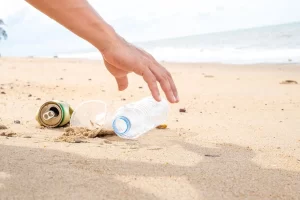Hey ocean lovers! Today, let’s talk about something that affects all of us and our beautiful marine friends – plastic waste in our oceans. It’s a topic that might seem overwhelming, but understanding it is the first step toward making positive changes. Let’s explore how plastic pollution impacts marine life and what we can do to help our underwater neighbors.
The Scale of the Problem: More Plastic Than Fish?
Did you know that every year, around 11 million metric tons of plastic enter our oceans? That’s like dumping a garbage truck full of plastic into the ocean every minute! If we continue at this rate, scientists predict that by 2050, there could be more plastic than fish in our oceans (by weight). Pretty shocking, right?
How Does Plastic End Up in Our Oceans?
Before we dive into the effects, let’s understand how all this plastic gets into our oceans:
- Direct Littering: Beach waste and coastal dumping
- River Transport: Plastic waste flowing through rivers into oceans
- Wind Dispersal: Light plastic items blown from landfills and streets
- Commercial Fishing: Lost or abandoned fishing gear
- Microplastics: Tiny plastic particles from cosmetics and synthetic clothing
The Big Impact on Marine Life
Entanglement: A Silent Trap
One of the most visible and heartbreaking effects of plastic pollution is entanglement. Marine animals like seals, dolphins, sea turtles, and seabirds often get tangled in abandoned fishing nets (ghost nets), plastic bags, and packaging straps. This can lead to:
- Restricted movement
- Difficulty finding food
- Problems breathing
- Severe injuries
- Sadly, in many cases, death
Ingestion: When Plastic Becomes “Food”
Many marine animals mistake plastic for food. Sea turtles often confuse floating plastic bags for jellyfish, while seabirds might mistake small plastic pieces for fish eggs. When animals eat plastic:
- It can block their digestive systems
- Create a false feeling of fullness, leading to starvation
- Release toxic chemicals into their bodies
- Cause internal injuries
The Microplastic Menace
Microplastics (pieces smaller than 5mm) are perhaps the most insidious form of plastic pollution. These tiny troublemakers:
- Are easily ingested by even the smallest marine organisms
- Work their way up the food chain through bioaccumulation
- Can bind with toxic chemicals, making them even more dangerous
- Are nearly impossible to remove from the environment
Ecosystem-Wide Effects
The impact of plastic pollution goes far beyond individual animals. It affects entire marine ecosystems in ways we’re only beginning to understand:
Coral Reef Damage
Coral reefs, often called the rainforests of the sea, are particularly vulnerable to plastic pollution. When plastic waste becomes entangled in corals:
- It can block sunlight needed for photosynthesis
- Create opportunities for disease
- Physical damage to fragile coral structures
- Affect the entire reef ecosystem that depends on coral health
Beach and Seafloor Alterations
Plastic accumulation on beaches and the seafloor can:
- Change the temperature and chemical composition of sand
- Affect animals that nest on beaches (like sea turtles)
- Disturb seafloor ecosystems
- Impact the exchange of nutrients between water and sediment
Impact on Marine Food Webs
The presence of plastic in marine environments disrupts natural food webs:
- Smaller organisms consume microplastics
- These organisms are eaten by larger animals
- Toxins concentrate as they move up the food chain
- Eventually, these impacts can reach humans who consume seafood
The Human Connection
We’re not just passive observers in this crisis – we’re both part of the problem and potentially affected by it:
- Microplastics have been found in human blood and organs
- Seafood contaminated with plastic-associated toxins enters our food supply
- Coastal communities face economic impacts from damaged marine ecosystems
- Tourism suffers in areas affected by visible plastic pollution
Hope on the Horizon: Solutions and Actions
While the situation is serious, there’s still hope! Here are some positive steps being taken and ways you can help:
Individual Actions
- Reduce single-use plastic consumption
- Properly dispose of waste and recycle
- Participate in beach cleanups
- Choose products with minimal packaging
- Use reusable bags, bottles, and containers
Community Level
- Support local plastic ban initiatives
- Educate others about plastic pollution
- Join or organize community cleanup events
- Support organizations working on ocean cleanup
Global Initiatives
- International agreements to reduce plastic waste
- Innovation in biodegradable materials
- Development of better recycling technologies
- Corporate commitments to reduce plastic packaging
The Role of Innovation
Exciting developments are happening in the fight against plastic pollution:
- New biodegradable materials being developed
- Improved recycling technologies
- Ocean cleanup technologies
- Alternative packaging solutions
Looking to the Future
While the challenge of plastic pollution is significant, there’s reason for optimism. More people than ever are aware of the problem and taking action. Governments worldwide are implementing stricter regulations, and innovative solutions are being developed.
Remember, every piece of plastic we prevent from entering the ocean is one less threat to marine life. Through individual actions, community efforts, and global cooperation, we can turn the tide on plastic pollution and protect our beautiful marine ecosystems for future generations.
What You Can Do Today
Start making a difference with these simple steps:
- Refuse single-use plastics whenever possible
- Bring your own shopping bags, water bottles, and coffee cups
- Choose products with minimal packaging
- Properly dispose of and recycle plastic items
- Spread awareness about plastic pollution
- Support organizations working to protect marine life
Together, we can create positive change and ensure a healthier future for our oceans and the amazing creatures that call them home. Every small action counts in this global effort to protect our blue planet!
Remember, the ocean connects us all, and its health is crucial for the entire planet’s wellbeing. Let’s be part of the solution and work together to keep our oceans clean and healthy for generations to come!

Leave a Reply